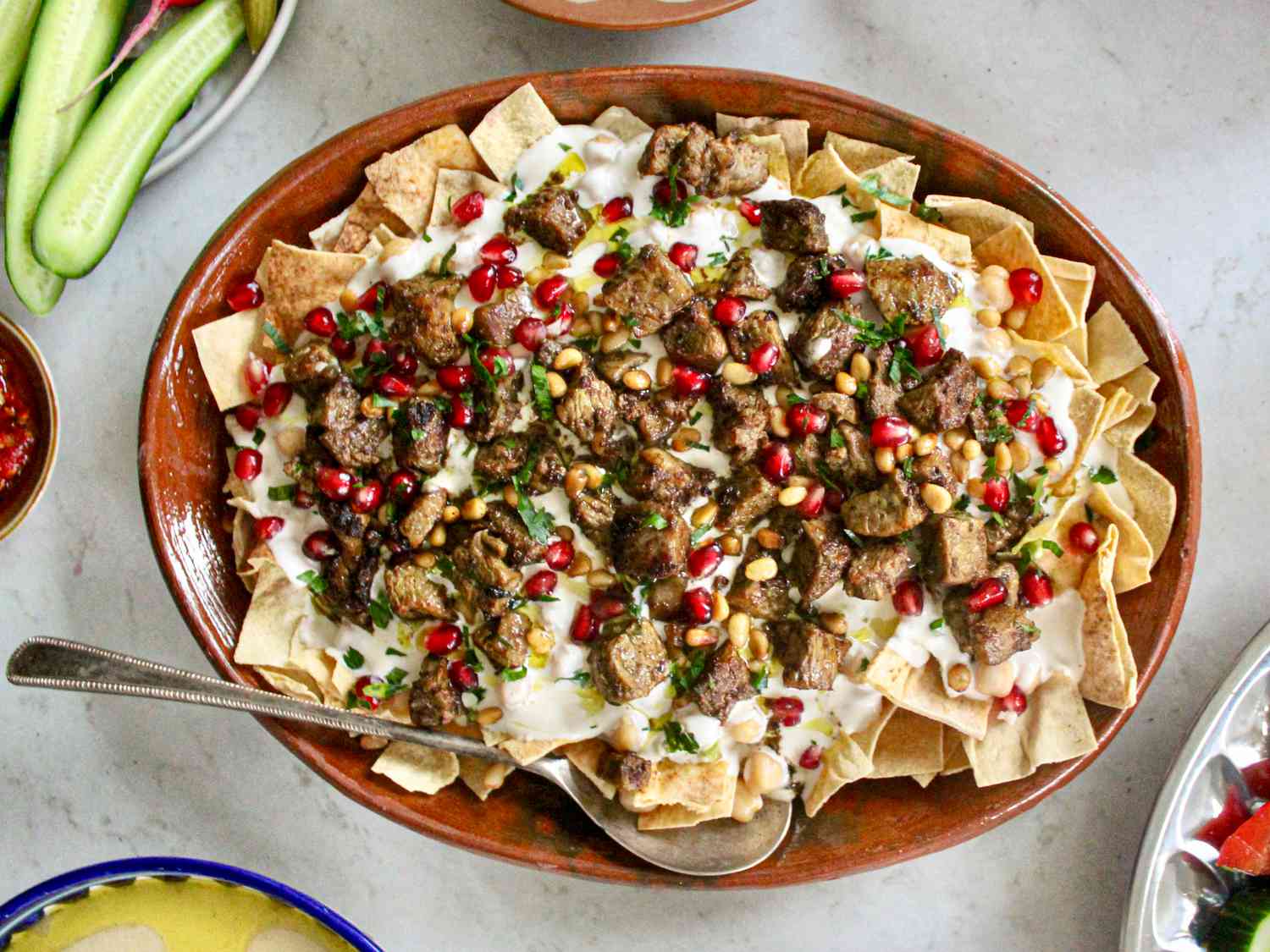
Why It Works
- Boiling the chickpeas from scratch permits you to use the flavorful broth within the ultimate dish.
- Utilizing a young, flavorful minimize of meat like beef or lamb loin permits you to prepare dinner it shortly—within the time it takes you to assemble the dish—without having to braise it.
- Toasting the bread helps it retain extra of its crispiness.
Fatteh is a flexible cooking method throughout the Levant—Syria, Lebanon, Jordan and Palestine—and different components of the Arab world like Egypt. Originating from the Arabic verb “fatt,” which implies “to interrupt bread and steep in liquid,” fatteh may be so simple as tossing day-old bread in lentil soup or right into a salad like fattoush, which can also be derived from the identical phrase. It may be a extra elaborate preparation wherein cooks soak stale bread in soup, stew, or yogurt-based dishes, then layer it with varied toppings, similar to chickpeas, eggplant, rice, and meat. These dishes are normally completed with a yogurt-, tahini-, tomato-, or lemon-based sauce and garnished with nuts, herbs, and spices for further crunch and taste.
Fatteh probably stems from each financial necessity and the provision of components. Traditionally, grains like rice weren’t as readily accessible as wheat, making bread the first carbohydrate for Levantine Arabs. Its widespread availability and affordability additionally made it an efficient approach of extending meals to feed extra individuals, particularly when meat was scarce and costly, or when different meals like legumes, grains, and recent greens have been restricted.
Regardless that bread stays a staple in the present day and continues to be a approach of stretching a meal for individuals residing with meals insecurity—like Palestinians underneath siege in Gaza in the present day—fatteh has transcended its origins as a dish of shortage. As an alternative, it’s now typically seen as a celebratory meal, with bread particularly ready for the dish, starting from toasted paper-thin slices to crispy fried pita. There are a lot of variations that incorporate complete dishes like kafta (floor meat patties) or msakhan (Palestinian flatbreads) into the fatteh format, alongside a plethora of sauces and garnishes.
Hummus fatteh (additionally generally referred to as fattet hummus) stands out as one of many oldest and most conventional types of fatteh, with its preparation various considerably throughout the Levant. Although its essence lies in its mixture of toasted bread with a chickpea and tahini combination, garnished with meat and pine nuts—or simply pine nuts for a vegetarian possibility—every household has their very own distinctive recipe. The tremendous particulars are dictated by private desire; some incorporate precise hummus b’tahini, whereas others could go for yogurt instead of tahini or use a creamy dressing created from whisking the chickpea cooking liquid and olive oil collectively.
The components checklist for this dish, or any fatteh dish, might sound lengthy at first. However a better look reveals they’re inexpensive pantry staples many individuals preserve available, and the dishes themselves quite simple to place collectively: simmering chickpeas, toasting pita, whisking collectively creamy yogurt with tahini, whipping up a zesty lemon dressing, and eventually, browning the meat. Although you don’t must, I like to recommend making ready the beans from scratch, which can assist you to use the flavorful chickpea-cooking water within the dish itself. But it surely’s additionally completely acceptable to reheat jarred or canned chickpeas in water till boiling and use that liquid to finish the dish, too.
This recipe is how my mom makes her hummus fatteh. After years of making an attempt totally different variations of the dish at eating places or different individuals’s properties, hers continues to be my favourite solution to eat and make it. It’s the quintessential Palestinian brunch meal, and also you rework humble components like chickpeas and pita into one thing really magical if you mix them with creamy tahini, tender, bite-sized items of fried meat, and toasted pine nuts.
As a lot as I like to mop up hummus with bread, I exploit a spoon to eat this explicit dish, the place the toasted pita is on the very backside to absorb all of the sauces and juices. For a scrumptious vegetarian model, merely skip the meat and add some further nuts—both extra pine nuts or any mixture of almonds, cashews, or pine nuts. With toasted pita, creamy chickpeas, and easy tahini, you’ll be able to at all times depend on hummus fatteh for a distinction of sentimental and crunchy, heat and funky, and a satisfying savoriness that begs you to assist your self to extra.
Trending Merchandise










